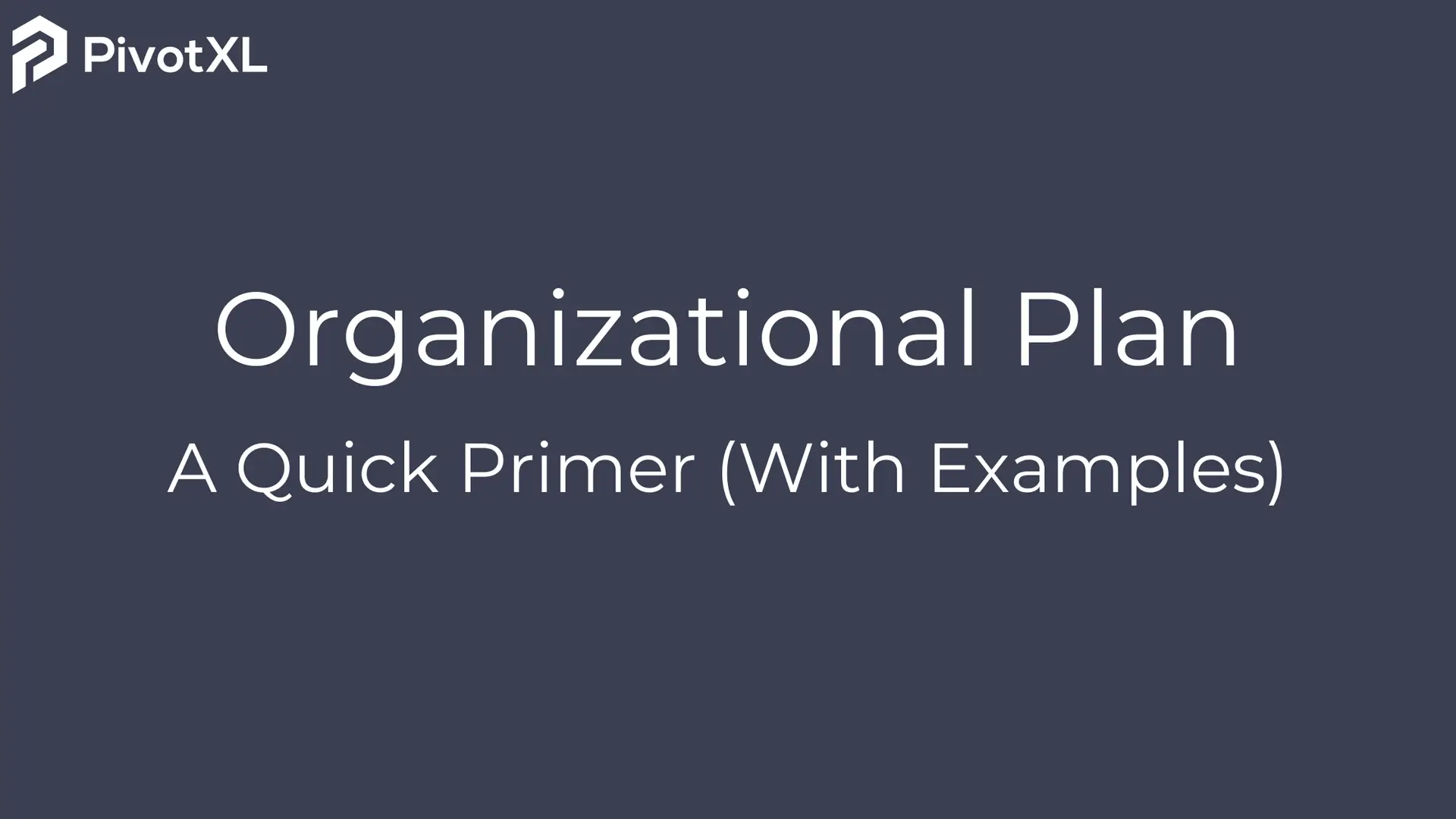Organizational planning is the process of strategizing and preparing for a business’s future successes. A well-structured organizational plan provides a roadmap for an organization’s operations, marketing, financials, staffing, and more, ensuring that all departments collaborate effectively to reach company goals.
A clear and actionable organizational plan allows businesses to anticipate market fluctuations and navigate economic changes without suffering losses. By defining where the company wants to go, businesses can focus their efforts and resources on achieving measurable outcomes.
What Are the Benefits of Organizational Planning?
If your company wants to grow, you need a game plan—this is the essence of organizational planning.
Beyond setting a path for growth, an organizational plan offers a range of benefits that help companies stay competitive, resilient, and efficient.
1. Clear Goals for the Organization
Organizational planning helps set achievable targets for the business and its teams.
It provides a structured vision, establishes measurable goals, and lays out a roadmap for how to achieve them. By creating this clarity, teams can align their efforts with the company’s larger objectives.
Organizational planning also creates feedback loops to track progress and identify areas needing improvement, ensuring that all departments contribute efficiently to company-wide goals.
2. Visibility Into Gaps or Opportunities
Organizational planning eliminates data silos and creates structured action plans, enabling companies to identify improvement areas or growth opportunities.
With increased visibility, businesses can develop stronger strategies and gain deeper insights into the factors driving success.
3. Improved Employee Morale and Productivity
Well-informed and motivated employees have higher job satisfaction and retention rates.
Organizational planning clarifies every team member’s role in achieving company goals, fostering a sense of purpose and engagement with the company’s mission.
4. Greater Resilience and Agility
A well-structured organizational plan helps companies make quick, informed decisions while keeping long-term goals intact.
Different types of organizational planning, such as financial planning, strategy implementation, and risk management, equip teams to handle uncertainty and disruption.
- Financial planning: Adjust budgets based on market conditions.
- Strategic implementation: Create a practical roadmap for success.
- Risk management: Anticipate and mitigate challenges before they escalate.
By leveraging these planning strategies, companies can adapt quickly to changing circumstances and remain competitive.
5. Cost Savings and Optimization
Having a clear plan minimizes wasted resources by preventing trial-and-error approaches.
An organizational plan provides teams with a structured framework for decision-making, leading to better financial outcomes and optimized spending.
Efficient planning also translates to improved profit margins, as businesses can allocate budgets more effectively while minimizing unnecessary costs.
Types of Organizational Planning
Organizational planning encompasses several approaches, each targeting different business functions.
Some key types of organizational planning include:
1. Strategic Planning
Strategic planning focuses on setting long-term goals, developing strategies, and allocating resources to achieve business objectives.
It involves assessing the company’s current position, forecasting future trends, and creating a vision while considering external factors such as market conditions, customer expectations, and competitive landscape.
A strategic plan typically outlines key initiatives, sets measurable objectives, and provides a framework for decision-making.
Example of Strategic Planning
- Vision: Become the leading provider of AI-driven financial analytics solutions.
- Strategy: Invest in AI-powered forecasting tools and expand partnerships with Fortune 500 companies.
2. Driver-Based Planning
Driver-based planning connects financial plans to strategic and operational activities, helping businesses identify and prioritize key actions that drive success.
This planning method incorporates financial goals and operational performance, linking business drivers—such as sales growth, customer acquisition, and production efficiency—to financial projections.
By using driver-based planning, organizations remain agile, adapting their strategies based on real-time market conditions and focusing on measurable results.
3. Tactical Planning
While strategic planning provides the big picture, tactical planning focuses on execution.
Tactical planning involves defining specific tasks, setting deadlines, and assigning responsibilities to ensure strategic goals are met. These plans are typically created quarterly or annually and include activities such as budgeting, marketing campaigns, and sales strategies.
Example of Tactical Planning
- Strategic Goal: Increase customer acquisition by 20% in the next year.
- Tactical Plan: Launch a multi-channel digital marketing campaign and expand the sales team.
4. Operational Planning
Operational plans serve as step-by-step guides for daily business functions.
They define specific tasks, set deadlines, and assign roles across departments, ensuring smooth day-to-day operations while aligning with larger company goals.
Example of Operational Planning
- Task: Ensure customer orders are shipped within 24 hours.
- Action Plan: Implement an inventory management system to optimize logistics.
5. Contingency Planning
Businesses must be prepared for the unexpected—this is where contingency planning comes in.
Contingency planning helps companies anticipate potential disruptions and create response strategies to minimize risks. These plans focus on business continuity, crisis management, and risk mitigation.
Example of Contingency Planning
- Risk: Supply chain disruptions due to external factors.
- Contingency Plan: Maintain backup suppliers and invest in inventory forecasting software.
6. Capacity Planning
Capacity planning helps businesses allocate resources efficiently to meet future demands.
It involves assessing workforce availability, infrastructure, and technology to ensure that the organization can handle growth, new projects, or market fluctuations.
By proactively managing resources, companies can scale operations smoothly without encountering bottlenecks.
7. Workforce Planning
Workforce planning focuses on aligning personnel with business needs, ensuring the organization has the right talent to execute its strategies.
This involves analyzing employment trends, identifying skill gaps, and implementing recruitment or training programs to enhance workforce capabilities.
Example of Workforce Planning
- Challenge: Shortage of data analysts to support business intelligence initiatives.
- Solution: Develop an in-house data training program and partner with universities for talent recruitment.
5-Step Organizational Planning Process
A successful organizational plan follows a structured process:
Step 1: Define Goals
Clearly outline your company’s main objectives and prioritize them. Break down larger goals into smaller, actionable steps.
Step 2: Analyze Current Processes
Evaluate your current operations, identify inefficiencies, and determine areas for improvement. Conduct research and data analysis to guide decision-making.
Step 3: Seek Stakeholder Input
Gather feedback from key stakeholders, including executives, employees, and industry experts. Their insights help refine strategies and identify additional resources.
Step 4: Develop a Plan
Define specific actions, assign responsibilities, set deadlines, and establish KPIs to measure success. Ensure all teams are aligned with the plan.
Step 5: Measure Results and Adjust
Track performance using key metrics, assess progress, and make necessary adjustments to stay on course. Continuous monitoring helps optimize strategies for better results.
Streamline Your Planning With PivotXL
Creating and managing organizational plans doesn’t have to be a daunting task. PivotXL simplifies the process by providing tools to centralize your data, streamline planning workflows, and foster collaboration across teams. With PivotXL, you can:
- Build detailed strategic and tactical plans.
- Monitor progress with real-time dashboards.
- Align teams by sharing plans seamlessly.
- Mitigate risks with built-in contingency planning templates.
Whether you’re looking to refine your strategic goals or streamline operational processes, PivotXL empowers your organization to plan smarter and achieve more.




